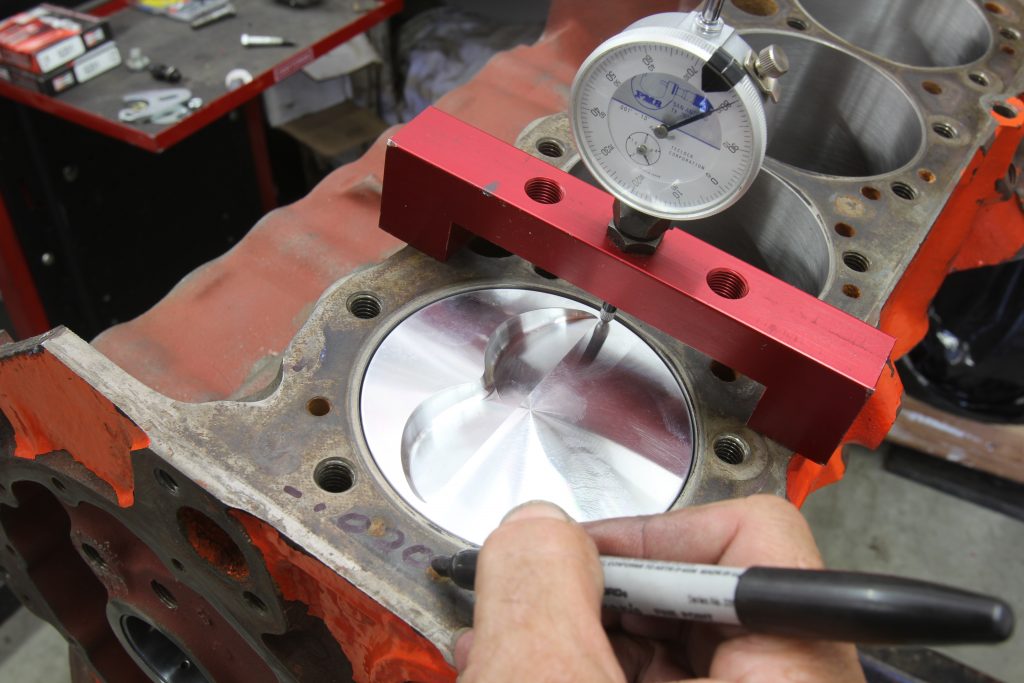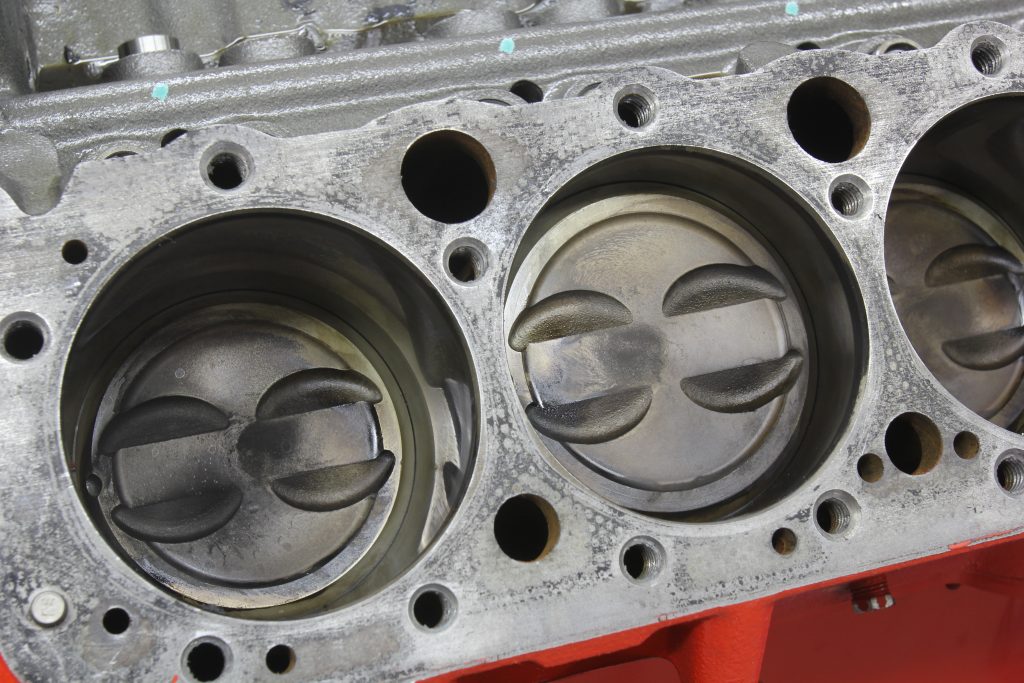Can You Increase Compression In A Car Engine Cylinder Without Major Repair
Is in that location a cheap style to increase compression on my small block Chevy? I have a 350 small block with iron heads. I don't know much near the engine because it came in the machine. The previous owner said it was rebuilt and has a cam but he couldn't remember the specs. The other parts are an Edelbrock Performer intake, a 600 cfm Holley carb, and cast iron exhaust manifolds. The engine runs fine on the cheap 87-octane stuff and doesn't ping at all. I'm thinking a little extra compression wouldn't' hurt only I tin can't afford a set of aluminum heads. What do you lot think? Cheers
J.H.
Jeff Smith: Raising the compression ratio is an excellent thought for several reasons. Assuming that the added compression is not excessive, adding pinch is the best way to improve power while also improving efficiency. There's a reason that all the latest generation LS engines and specially the new gasoline straight injection (GDI) LT1 Corvette engine accept college compression ratios. The LT1 is designed to operate with premium fuel merely comes from the manufactory with a true eleven:one static pinch ratio.
Having said that, y'all tin't run that much compression on a modest block Chevy using older, '70s vintage iron heads. Nosotros won't go into all the details as to why but suffice to say that those older combustion chambers were non designed to suit that kind of compression. Internal combustion engineering has come a long way to achieve these higher static compression ratios and still operate on 91-93 octane fuel.
Since we don't know much near your 350 pocket-size block, we'll assume it employs the typical flat top, four eyebrow production pistons. With a composition head gasket, the piston 0.020-inch beneath deck, and a 76cc combustion bedroom, and with a composition head gasket this puts the static pinch at 8.5:1. This really isn't bad. The standard Chevy 290-horsepower 350 Chevy crate engine you can buy isn't fifty-fifty that good. Chevy'due south literature states this is an 8:1 compression engine, and that's what nosotros found when we measured one of these engines a couple of years ago. This engine uses a dished piston with xiii cc's of volume that reduces the compression.
One of the dimensions that is non easily changed is the distance from the piston elevation to the deck. In my pinch ratio equation, I assumed the piston is 0.020-inch beneath the block deck surface, which is excessive, just we can apply that to our advantage. If the pistons are closer to the deck (0.005-inch below for instance), this improves the compression ratio but also limits the thickness of the caput gasket since we are limited to roughly 0.040-inch for piston-to-head clearance. With a 0.020-inch negative deck height, this means we tin can use a thinner head gasket to improve the pinch.
Of form, this means removing the cylinder heads to brand this improvement and that'south where many guys don't want to make the effort. Here's how information technology works. Nosotros'll assume that your engine is currently using a composition head gasket. These are quality head gaskets merely are mostly 0.041-inch thick. Calculation the 0.020-inch deck top to the 0.041-inch caput gasket creates a distance of 0.061-inch betwixt the height of the piston and the flat portion of the cylinder head. This is called the quench area.
It's interesting that many enthusiasts tend to overlook the combustion space as a place to improve engine power. The quench surface area is that flat portion of the piston that matches the flat portion of the combustion bedroom on a wedge blazon cylinder head.
When the piston achieves peak expressionless middle (TDC), this creates a very tight clearance between the apartment portion of the piston and the flat portion of the head. This area is chosen the quench space or sometimes called squish–which is a really good descriptor of its purpose. The quench area is designed to squeeze the trapped air and fuel in this area and squish it into the combustion chamber, creating turbulence. The key to quality combustion is to mix the air and fuel – or homogenize it. The quench area helps this process which tends to stabilize the speed of combustion once the spark plug lights.
The tighter you tin can become this quench area–or the piston-to-head clearance–the better the engine will run. Moving the piston closer to the deck surface as well increases the static compression ratio. There is also a limit to piston-to-head clearance. Generally, for a low rpm street engine, you could be condom at 0.040-inch or slightly tighter. High rpm race engines with steel rods will fit into the same clearance but aluminum rod engines must use more than clearance (perhaps effectually 0.050-inch) to accommodate the growth of the aluminum rods.

This photo shows checking the piston-to-deck clearance with a dial indicator. This is important information for blueprinting an engine and for accurately calculating the static compression ratio. It's as well critical for knowing the piston-to-head clearance.
Since it will non exist feasible to detach your engine and deck the block, in that location'due south an alternative idea. Fel-Pro makes a steel shim head gasket with a very thin rubber coating for a 4.00-inch bore 350 that is only 0.015-inch thick. When added to your 0.020-inch deck acme, this produces a 0.035-inch piston-to-caput clearance. This is a little tight but should exist fine for a mild street engine that does non see engine speeds beyond six,500 rpm.
The good news is that this gasket volition bump the static compression ratio up to 8.97:ane or essentially nine:1, which is worth roughly a one-half a signal in compression. A rule of thumb for engine is that a total point of compression is worth roughly three to four percent of engine ability. Bold 300 horsepower on your engine, a half-point of compression is probably worth almost 2 percent – which is only 6 horsepower. That sounds like a lot of piece of work for a minimal comeback, but my guess is that low-speed torque will also ameliorate at least this much if not possibly a fleck more than.

Here is a photo of a 290-horsepower small cake with dished pistons. If your engine has these pistons, expect the pinch to be around eight.0:i which is at least 1.5 ratios away from where it needs to be. The easiest way to better pinch is with a set of 64cc chamber cylinder iron Vortec heads and that 0.015 head gasket, which will push the compression up to ix.0:1
Ane further recommendation would be to add a set of mid-length headers to the engine. This volition do more to add ability than whatsoever other thing you lot can exercise. Adding headers on a 290-horsepower small block was worth 30 ft.-lbs. of torque and 30 horsepower to that otherwise stock engine. My suggestion would be to do both the head gasket and the headers and so you will definitely need to re-jet the carburetor slightly richer unless it was excessively rich to begin with–which is too possible.
Source: https://www.onallcylinders.com/2017/03/24/how-to-increase-compression-on-the-cheap/
Posted by: baisdenbefer1961.blogspot.com


0 Response to "Can You Increase Compression In A Car Engine Cylinder Without Major Repair"
Post a Comment